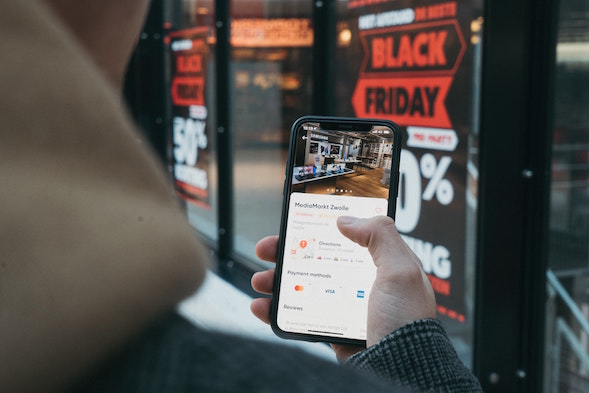Because of the COVID epidemic, the customer buying journey has significantly changed in all aspects, from the way consumers interact to how brands appear on different platforms. Headless commerce is the answer to adapt to the fast-moving business environment so that brands can rapidly meet flexible demands.
Headless commerce is a topic of universal interest but least understood in the eCommerce world. In this post, we’ll reveal what headless commerce is and why it’s the best solution for your brands. Let’s go!
What is headless commerce?
Headless commerce is an eCommerce architecture where retailers separate the frontend of their website from the eCommerce functionality in their backend.
In a normal eCommerce website, the frontend displays contents and information in a user-friendly way while the backend’s server applications process the requested database. In the headless commerce architecture, developers can store, handle, and publish content in the frontend without touching any backend functions.
Headless commerce utilizes Application Programming Interfaces (APIs) to bring high-quality content for customer experience at all kinds of displays and devices.
Developers can decouple the presentation layers (usually frontend templates or themes) to deliver content in all kinds of desired frameworks. Meanwhile, at the bottom layer, developers can manage all large practical components of the platform such as:
- Security
- Fraud management
- PCI compliance
- ERP
- OMS
- CRM
Based on this explanation, headless commerce architecture is a will and must for retailers in the IoT age. Opposite to the traditional commerce platforms where the frontend’s tightly screwed with the backend, headless commerce gives retailers the ability to be flexible and change fast using only one existing ecosystem.

Headless commerce vs. traditional commerce: A comparison
Frontend development
Traditional commerce platforms
In the traditional commerce system, frontend developers have to face too many restrictions on system design and process. All modifications need to rewrite everything from the database, code, to the frontend templates. This inconvenience limits the developer’s ability to edit or update the system quickly to adapt customer experience.
Headless commerce platforms
Headless commerce platforms allow frontend developers to directly improve the customer experience to increase sales and meet business targets. With API, developers can connect the frontend and backend easily, while avoiding unwanted changes to the backend databases.

Flexibility and adaptability
Traditional commerce platforms
The frontend in traditional systems is closely coupled with the backend coding and infrastructure, so there’s very little room to create any customizations. Even small customization leads to adjusting numerous layers of coding from the database in the backend to the frontend.
Headless commerce platforms
As the frontend has been decoupled from the backend in headless commerce, it offers the freedom for any desired customization. When you need to modify anything, from small changes like adding user account information, to big changes to the checkout process, you’ll only need to hire a frontend developer who will straightforwardly implement the changes to the frontend of your headless commerce architecture.
Examples of headless commerce
Example of headless Magento 2 with AngularJS framework: Oliver Bonas
Oliver Bonas is top-of-mind in perfume and cosmetic goods, but they still found headless commerce the solution to enhance revenue across devices. They aimed to personalize frontend customers for buyers wants and needs. They saw a significant rise in sales from mobile applications.

Example of headless Magento + custom JS frontend: Big Green Egg
After adapting headless commerce, Big Green Egg company has become one of the most popular grill and appliances retailers. They built a responsive web that worked better with their business chain systems. As a result, their mobile marketing has been gradually optimized, leading to increased conversions.

Example of headless React PWA + AMP: Lancôme
To give a complete customer experience across all devices and channels, Lancôme decided on a headless approach with the React PWA. This helped their website run smoothly, improved performance, and kept it user-friendly.

The pros and cons of headless commerce
Between traditional and headless commerce, headless commerce seems to be a much better option for eCommerce brands in terms of customer experience. However, eCommerce brands should carefully consider the trade-offs such as budget and time before adopting the new headless commerce architecture.
Headless commerce: The pros
Seamless integrations
By making an API call, the headless commerce solution can easily integrate and communicate across different platforms. This enables you to display your brand on all old and new devices, growing the possibilities to reach more target customers at the same time. Additionally, it only takes you a few hours to integrate your platform into any new systems.

Faster change and better flexibility
With a headless system, businesses can deliver content to all kinds of eCommerce channels with different content management systems. That means your content can appear through web applications, digital screens in elevators, or even refrigerators.
Headless commerce systems ensure that you can update information on the latest products and campaigns to your customers without editing the backend. In addition, it is easy to change anything to match the fast pace of customer technology.
For big commerce brands still implementing traditional commerce systems, they often make updates weekly or every few weeks. Compare this to Amazon, one of the examples of headless commerce, who implement updates roughly every 12 seconds. Headless commerce allows eCommerce brands like Amazon to reduce the duration of downtime.
When the frontend and backend have been decoupled, there’s no need to roll out an update to the whole system. It helps your brand publish information that your customers demand more rapidly, which ensures your brand’s competitiveness in the market.

Better customer experience and higher conversion rate
There’s no doubt that consumer demands change, but they might expect the consistency of their experience throughout all channels and devices.
Additionally, consumers expect eCommerce brands to not only provide products that fit their demands but also suggest what they might need through all channels. That means “a person who buys A will also buy B” isn’t enough anymore. Because the backend systems already record customer’s shopping lists, you can analyze your database to improve personal features on your website, social channels, and applications.
In a big campaign, you need to test different templates and approaches to see which ones bring in the most customers. For example, you can simultaneously test a new backend customer function while retaining the existing frontend function.
Your headless commerce system lets developers run constant trials, tests, or optimizations. Because you can experiment and improve your experience faster than other brands, you can have a better understanding of consumers and increase conversion rate.

Faster growth and campaign launching for marketing
Thanks to the flexibility of the headless commerce system, your marketing team can launch a new page within a few days rather than months like the traditional system. This helps speed up the new campaign’s launch from weeks to days.
In addition, scaling your marketing efforts to build an omnichannel experience is much easier with headless commerce. With the traditional eCommerce systems, building an omnichannel or multichannel experience seems extremely time-consuming and heavily scaling.
In headless commerce systems, you only need to concentrate on improving frontend experiences across multiple devices and touchpoints. This means that you have a faster time-to-market and more chances to implement new channels, approach new markets, and expand further.

Headless commerce: The cons
High cost
There’s no frontend in the headless commerce platforms, so developers need to build their own. Developing frontends and APIs from scratch can be quite costly and time-consuming, especially for multiple devices and touchpoints. Additionally, it could lead to a higher maintenance cost to troubleshoot the frontend creations.
Isolated environment for marketers
Since there’s no frontend presentation layer in the headless commerce systems, the marketing team has some problems:
- They have to rely on other teams to quickly update, create, approve and post content.
- The marketers cannot preview how content will display on the end user’s screen or devices.
The new era of commerce is headless
COVID-19’s lead to many changes in our life, from the way people travel, work, eat, relax, and also shop.
The consumer purchasing activities and the ratio between offline shopping and eCommerce have changed drastically. Between 2009 and 2019, the eCommerce rate in the US gradually grew from 6% to 16%. However, this rate surged up to 27% during only 2 months after COVID-19.
Customers have rapidly adapted to the convenience and ease of eCommerce, and their expectations for the retail industry won’t be the same. Store appearance becomes more powerful than ever, and this influences the future of commerce as well.

Retailers gain lots of benefits from headless commerce such as A/B testing, rapid prototyping, and better performance when they decouple their frontend and the backend of their eCommerce site. Headless eCommerce solutions can bring a massive ROI and deliver a better customer experience on eCommerce websites. This leads to a better brand image, increased conversion rate, and higher revenue. We can clearly see a new era of commerce where headless technique plays a major role.
With headless commerce being a rising trend, Magento is one of the eCommerce platforms supporting us to reach a headless future. Magento merchants can leverage Magento APIs to connect this platform to another CMS, ERP, or POS system.
In addition, Magento allows businesses to build their own online storefront with PWA Studio.
Conclusion
Headless commerce is a decoupled solution that helps enhance both customer journey and business chain. This solution allows your brands to adapt faster without the need to rebuild anything while still achieving potential revenue.
After this post, you should have all the necessary basic information about headless commerce. To decide whether it is right for your brand, you need to consider your expectations about time-to-market speed, system control, and flexibility.
If your business aims to meet standard revenue and requirements, traditional commerce is your suitable choice. But if you expect innovation, faster scale, rapid change, and lower overall costs, headless commerce is the better solution for your brand.













